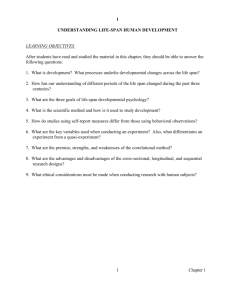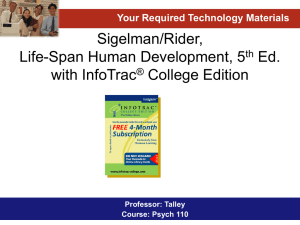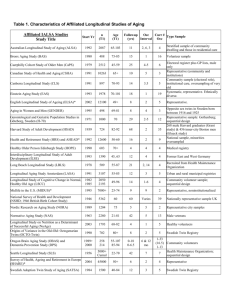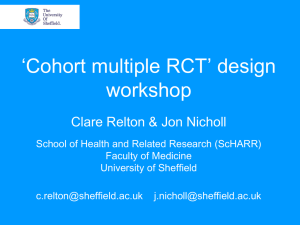IV. Methods of Studying Aging
advertisement
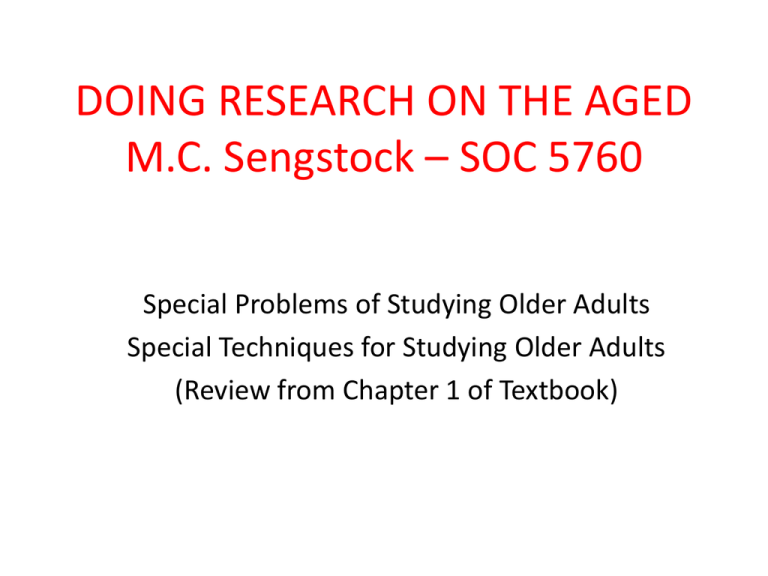
DOING RESEARCH ON THE AGED M.C. Sengstock – SOC 5760 Special Problems of Studying Older Adults Special Techniques for Studying Older Adults (Review from Chapter 1 of Textbook) WHY OLDER ADULTS ARE DIFFICULT TO STUDY • Any Subgroup of Population Is Particularly Difficult to Study • Inappropriateness of Normal Research Techniques: Representative Sample of Population – Every 1,000th Phone Number or Name in List – Gives Picture of TOTAL Population – Inadequate Sample of Sub-Groups: • Elderly – African-Americans – Teenagers – Etc. TRADITIONAL SAMPLING & THE ELDERLY • • • • • Traditional Sample of 1,000 in Population Would Yield Approximately 130 Elderly What Generalizations Can Be Made? What Is Needed to Make Generalizations? Need Special Sampling Techniques MAIN PROBLEM STUDYING ELDERLY • Interpreting “Change”: – Which Changes Result from Growing Older? – Which Are Characteristic of a Specific Category (“Cohort”) of Elderly? – EX 1: Elderly Distrust Banks – All Elderly? Or Those from Depression Period? – EX 2: Don’t Understand “Modern” Ways – All Elderly? Or Those Who Never Learned Them? STUDYING “CHANGE” • Most Questions We Ask About Aging: • Focus Is on CHANGE: How Do People Change As They Grow Older? • Interpreting Changes in a Specific Study: – Characteristic of ALL Individuals As They Age? – Or Only Characteristic of THIS COHORT of Elderly Who Are Aging RIGHT NOW? – EX: Depression Elderly DISTRUST Banks … – BUT 21st Century 70 Yr Olds TRUST Banks! INTERPRETING DATA ON THE AGED • How Do You Know if the Changes You See Are Characteristic of ALL Aged Persons – or Only This Particular Cohort of Aged? • How Is Being 80 Different From Being 50? • Irrespective of Whether You Are 80 in – 1970 – 1990 – 2010? • Will 80 Yr Olds Be Like This in 2040? SUMMARY OF RESEARCH PROBLEMS • Difficulty of Studying a Category Which Represents a Small Proportion of Population • Difficulty of Studying CHANGE in a SINGLE POINT IN TIME • Difficulty of Distinguishing Between Effects: COHORT vs. AGE 2 MODELS OF AGING • COMPETENCE MODEL: Individual’s Ability to Deal With Problems of Life – Why Do Some People Manage Better than Others? • ENVIRONMENT PRESS Model: Impact of Environment on an Individual – How Do the Experiences One Has Had Impact on Their Ability to Manage Stress? – Impact of Social & Economic Stresses on Coping • EX: Minority Status; Low Income; Historical Events REQUIREMENTS FOR AGING RESEARCH • Simply Looking at an Older Population vs. a Younger Population Is Insufficient • Need to Be Able to Separate Out The Different Effects: AGING PROCESS – COHORT IMPACTS BALTIMORE LONGITUDINAL STUDIES OF AGING • • • • Landmark Studies Conducted in 1950s & 1960s Contributed Significantly to Study of Aging Mainly Through Suggesting New Methodologies 3 RESEARCH DESIGNS • Longitudinal Research • Cross-Sectional Research • Sequential Research LONGITUDINAL DESIGNS: METHOD & ASSETS • • • • Study Same People – “PANEL” – Over Time Eliminates (Controls for) Cohort Effects Effective in Comparing Age & Cohort Effects Permits Inference About Changes Related to Aging LONGITUDINAL DESIGNS: PROBLEMS • Serious Methodological Difficulties: – Difficult to Retain Entire Sample – People Get Sick & Quit or Die – Get Tired of Being Interviewed Numerous Times • Most Difficult to Do • Very Expensive CROSS-SECTIONAL DESIGNS: METHOD & ASSETS • Studies a Number of Subjects of Different Ages on the Same Characteristics • Allows Researchers to Compare Subjects of Different Ages • How Are “Older” People Different from “Younger” Ones? CROSS-SECTIONAL DESIGNS: PROBLEMS • Sorting Out Cohort Effects Remains • Q Remains: Are Some Subjects “Unusual” Members of their Cohorts? • How to Determine Whether Observed Changes Are Due to Age Itself – Or Cohort SEQUENTIAL DESIGNS: METHOD & ASSETS • Modification of the Longitudinal Design • Does NOT Interview a PANEL • Interviews DIFFERENT Members of the Same Cohort at Different Points in Time • Allows Researchers to Analyze Relative Influence of AGE vs. COHORT • Avoids Problems of Retaining Same Subjects Over Extended Period of Time SEQUENTIAL DESIGNS: PROBLEMS • Difficult & Time-Consuming to Conduct • Though Not As Difficult As Longitudinal SUMMARY OF RESEARCH TYPES • LONGITUDINAL: Same Subjects – Interviewed Several Times – Allows Age/Cohort Comparisons • CROSS-SECTIONAL: Different Subjects – Interviewed Once – Little Ability to Analyze Age-Cohort Distinctions • SEQUENTIAL: Different Subjects – Allows Controls for Age/Cohort Differences – Less Expensive Than Longitudinal ALL STUDIES ON AGED • Problems With Lack of Diversity of Subjects • Difficulty Getting “Lists” for Samples • Lists Often Biased (e.g, AARP Lists) – Exclude Minorities; Retiree Lists Omit NonWorkers • Old People Resist Participating in Studies – Tuskegee Impact – General Distrust of Science – Other Interests (Bingo!) SUMMARY: RESEARCH ON AGING: PROBLEMS & ASSETS • Research on Aging Requires Different Methodologies • Makes It More Expensive • Makes It Difficult to Recruit Subjects • Makes It Difficult to Sort Out Differences Between AGE & COHORT Differences

